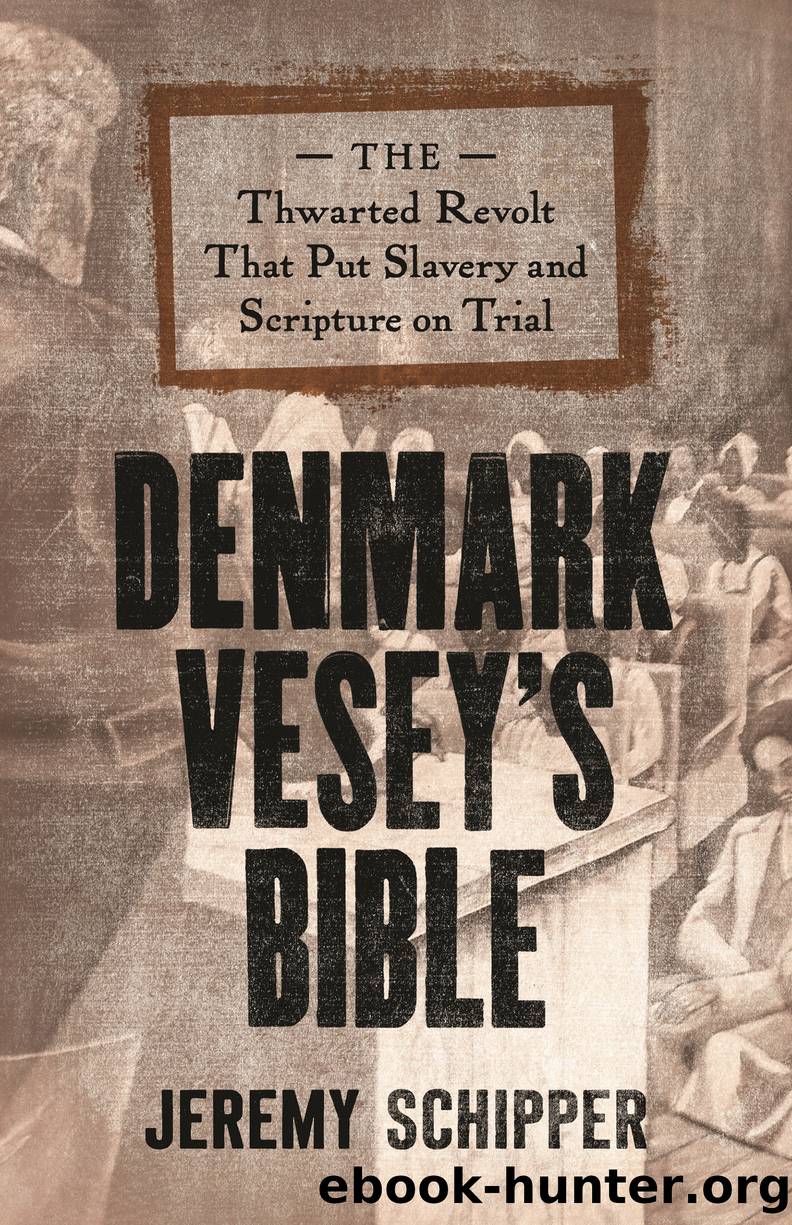Denmark Vesey's Bible by Jeremy Schipper

Author:Jeremy Schipper
Language: eng
Format: epub
Publisher: Princeton University Press
Published: 2021-11-25T00:00:00+00:00
In addition to its request for a day of public humiliation and thanksgiving, the earlier letter, from September 1822, to Governor Wilsonâs predecessor had a second objective. Acknowledging the fear in the white community that enslaved people who had read the Bible would find inspiration in its pages for future insurrections, the letter observed that this fear led some in the community to seek legislation âto prevent their learning to read [the Bible], or to use it freely.â4 The letter sought to address this fear and argue against such legislation. âThe Scriptures,â argued the letterâs authors, âare given to Man (without respect of Persons) to make him wise unto Salvation.â5
Furman and the other coauthors took the phrase âwise unto Salvationâ from 2 Timothy 3:15: âAnd that from a child thou hast known the holy scriptures, which are able to make thee wise unto salvation through faith which is in Christ Jesus.â Exposure to the Bible, in other words, is essential if one is to embrace Christianity. Furman and the Charleston Bible Societyâs board of managers believed that all people, regardless of their race or station in life, should have the opportunity to become Christians. As noted in the previous chapter, Benjamin Morgan Palmer, one of the vice presidents of the Charleston Bible Society, preached a sermon the day before the letter was written, arguing that Christianity benefited everyone. Thus, it is not surprising that the letter would declare, âall are required, by Divine Authority to read them [the scriptures]; because they contain the Words of Eternal Life. To prohibit the use of them therefore, in respect of any man or class of men, is to contradict & oppose the Divine Authority.â6
Despite its use of biblical phrases like âwise unto salvation,â the September 1822 letter explicitly quotes only one biblical text, and only in a footnote. While acknowledging that many people believe âthat the Doctrines of Holy writ are unfavourable to the holding of Slaves,â the authors assert that slaveryâs âlawfulness is positively stated in the Old Testament, & is clearly recognized in the New. In the latter a luminous Exhibition is given of Slaves.â7 Yet the letterâs authors do not identify the specific texts from the Old Testament that they have in mind. The sole New Testament text, consigned to a footnote, is 1 Timothy 6:1â2. (As noted in the previous chapter, this text figured prominently in Benjamin Palmerâs Religion Profitable. As Palmer was also a vice president of the societyâs board of managers, it is very likely that this citation reflects his influence. Although the letter is signed collectively as âYour Obedient Humble Servantsâ and the biblical references suggest Palmerâs input, its main architect was Richard Furman.)8 In the very next sentence after they footnote 1 Timothy 6:1â2, the authors argue that although slaveholders and the enslaved enjoyed âMembership together in the Christian Church,â slaveholders are not obligated âto emancipate their Slaves, but to give them the things which are just, and equal, forbearing Threatening, & remembering that they also have a Master in Heaven.
Download
This site does not store any files on its server. We only index and link to content provided by other sites. Please contact the content providers to delete copyright contents if any and email us, we'll remove relevant links or contents immediately.
| African Americans | Civil War |
| Colonial Period | Immigrants |
| Revolution & Founding | State & Local |
Cat's cradle by Kurt Vonnegut(15257)
Pimp by Iceberg Slim(14433)
4 3 2 1: A Novel by Paul Auster(12329)
Underground: A Human History of the Worlds Beneath Our Feet by Will Hunt(12052)
The Radium Girls by Kate Moore(11970)
Wiseguy by Nicholas Pileggi(5707)
The Fire Next Time by James Baldwin(5380)
Perfect Rhythm by Jae(5354)
American History Stories, Volume III (Yesterday's Classics) by Pratt Mara L(5274)
Paper Towns by Green John(5136)
Pale Blue Dot by Carl Sagan(4953)
A Higher Loyalty: Truth, Lies, and Leadership by James Comey(4905)
The Mayflower and the Pilgrims' New World by Nathaniel Philbrick(4458)
The Doomsday Machine by Daniel Ellsberg(4449)
Killers of the Flower Moon: The Osage Murders and the Birth of the FBI by David Grann(4409)
The Sympathizer by Viet Thanh Nguyen(4338)
Too Much and Not the Mood by Durga Chew-Bose(4302)
The Borden Murders by Sarah Miller(4275)
Sticky Fingers by Joe Hagan(4143)
